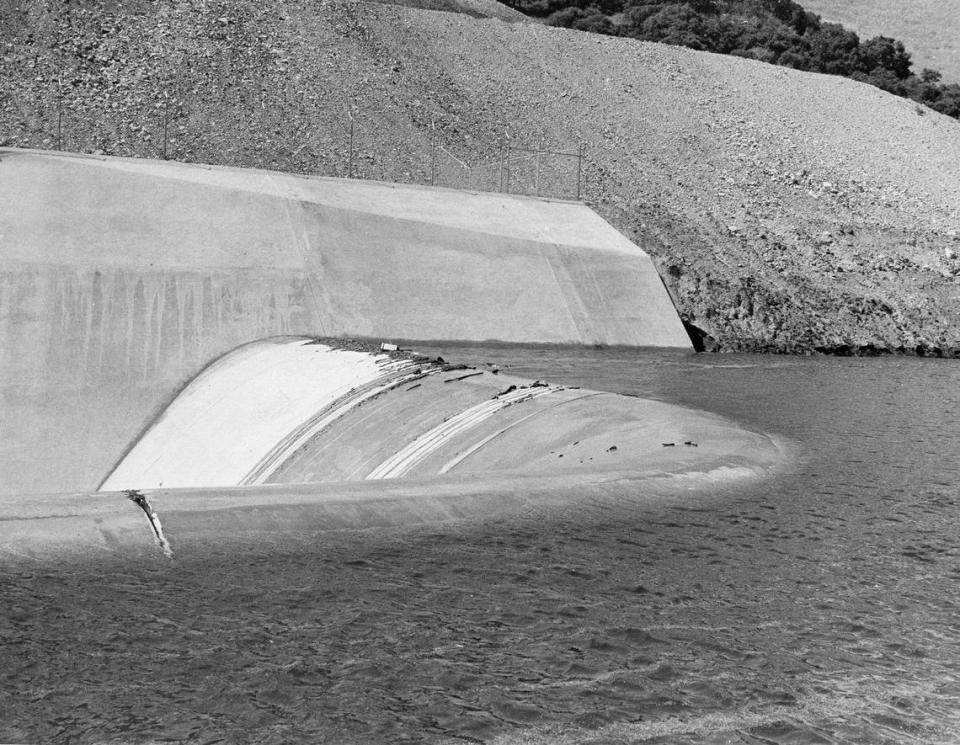Lopez Lake just spilled for the first time in 25 years. When did reservoir first fill?
Lopez Lake was completed in 1969 and expected to fill by 1973 or 1974.
Then the epic rains of 1969 arrived.
It only took three and a half months to lift water levels at the man-made reservoir near Arroyo Grande.
On Thursday, Lopez Lake spilled for the first time in 25 years — becoming one of the last local reservoirs to reach full capacity and overflow after a winter with heavier-than-usual storms.
There’s been so much rainfall that San Luis Obispo County now has no dry or drought designations whatsoever, according to the U.S. Drought Monitor.
That’s a big change from Dec. 7, when Lopez Lake was at 22% capacity. Water levels were so low that you could see the remnants of an old road on the lake bottom.
The idea for Lopez Lake germinated in the 1960s.
Flood control and recreation were benefits but the major driver was the need for a new water supply.
Drinking water wells along the coast were suffering from “extreme saltwater intrusion,” according to an Aug. 18, 1965, story by Telegram-Tribune reporter Pat Keeble.
Community members including activist and Pismo Beach park namesake Margo Darling Dodd formed a Citizens Committee for Lopez Dam.
“We have had the ‘pleasure’ of cleaning our teeth with saltwater,” Dodd, a Sunset Palisades resident, said at the time.
Getting the Lopez Lake project underway wasn’t easy.
There were years of funding and jurisdiction squabbles, as well as an eight-day civil court trial in 1967.

It took two years and $16.5 million to build the dam that would flood the valley. Construction began with a public invitation to witness the first blast of dynamite.
Dedication ceremonies for Lopez Lake held on May 17, 1969.
A front-page story that ran on April 19, 1969, reported that George Romney, then serving as secretary of Housing and Urban Development under President Richard Nixon, wrote a letter to the county of San Luis Obispo congratulating it on preventing up to $5 million in downstream flood damage.
The dam underwent a $26 million seismic retrofit in 2001 and 2002.
Today, Lopez Lake serves as a water source for southern San Luis Obispo County as well as a popular recreational destination for boating, fishing, camping and swimming.
This story by Jack Magee was published Jan. 4, 1969, in the Telegram-Tribune when the dam was just starting to fill.
Lopez Lake — A big economy splash
The Lopez Project is now Lopez Lake.
Water already is being stored behind the huge, sprawling earthfill dam.
Completion of the main project is scheduled by May in time for the summer, just two years from the start of construction. Total cost will be about $16.5 million.
“If the dam had been completed in December of 1966, the lake would be two-thirds full now,” says county hydraulic engineer Robert Born.
That would be because of the heavy rainfall two years ago.
Runoff from the Lopez Canyon watershed’s two feeder streams, Arroyo Grande and Lopez creeks, has poured about 1,000 acre-feet of water into storage so far—since storing began in October.
Capacity is 50,000 acre-feet. Deliveries of water to contractors along the pipeline now under construction can commence after the 4,000 acre-foot minimum pool is achieved. Service will extend as far as Avila Beach.
Though the primary purpose of the dam is to provide an additional water supply to supplement wells in the South County, it also will serve as a flood control and recreational facility.

The spillway is designed to take care of the one-in-a-thousand-year storm, with its bed of concrete about 12 feet thick.
Safety of the dam was certified by the state this week. The structure rises 160 feet above the ground, measures 830 feet along the crest and tapers from a thickness of 1,300 feet at the bottom to 40 at the top.
A unique aspect of Lopez Lake will be the allowance for body contact water sports on the 940-acre surface of the 22 mile shoreline.
This feature, now provided by popular Lake Cachuma in the Santa Ynez Valley of south Santa Barbara County, is made possible by the terminal reservoir.
The terminal reservoir fed by pipeline downstream from the main one, has but one purpose: to hold the water before delivery long enough for any viruses in it to die.

Bacteria and sediment will be taken care of by the treatment plant. But detention in the terminal reservoir is the only practical way to remove the viruses.
Some 600,000 visitors a year are expected to use the area’s recreational facilities, which will include more that 200 camp sites, over 150 picnic areas and 144 trailer sites.
Construction alone has already pumped millions of payroll dollars int the area’s economy and this is expected to be capitalized by patronage of visitors — some with their eyes on the 20,000-plus trout a year to be planted in the lake.


